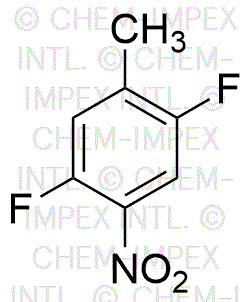2,5-Difluoro-4-nitrotoluene is widely utilized in research focused on:
- Pharmaceutical Development: This compound serves as an intermediate in the synthesis of various pharmaceuticals, particularly in the development of anti-inflammatory and analgesic drugs, enhancing their efficacy and safety profiles.
- Agricultural Chemicals: It is used in the formulation of agrochemicals, including herbicides and insecticides, providing effective solutions for pest control while minimizing environmental impact.
- Material Science: The compound is explored in the development of advanced materials, such as polymers and coatings, due to its unique chemical properties that enhance durability and resistance to degradation.
- Analytical Chemistry: It plays a role in the development of analytical methods for detecting and quantifying nitro compounds in environmental samples, aiding in pollution monitoring and regulatory compliance.
- Research on Fluorinated Compounds: Its structure allows researchers to study the effects of fluorination on chemical reactivity and stability, contributing to the broader understanding of fluorinated organic compounds in various applications.
General Information
Properties
Safety and Regulations
Applications
2,5-Difluoro-4-nitrotoluene is widely utilized in research focused on:
- Pharmaceutical Development: This compound serves as an intermediate in the synthesis of various pharmaceuticals, particularly in the development of anti-inflammatory and analgesic drugs, enhancing their efficacy and safety profiles.
- Agricultural Chemicals: It is used in the formulation of agrochemicals, including herbicides and insecticides, providing effective solutions for pest control while minimizing environmental impact.
- Material Science: The compound is explored in the development of advanced materials, such as polymers and coatings, due to its unique chemical properties that enhance durability and resistance to degradation.
- Analytical Chemistry: It plays a role in the development of analytical methods for detecting and quantifying nitro compounds in environmental samples, aiding in pollution monitoring and regulatory compliance.
- Research on Fluorinated Compounds: Its structure allows researchers to study the effects of fluorination on chemical reactivity and stability, contributing to the broader understanding of fluorinated organic compounds in various applications.
Documents
Safety Data Sheets (SDS)
The SDS provides comprehensive safety information on handling, storage, and disposal of the product.
Product Specification (PS)
The PS provides a comprehensive breakdown of the product’s properties, including chemical composition, physical state, purity, and storage requirements. It also details acceptable quality ranges and the product's intended applications.
Certificates of Analysis (COA)
Search for Certificates of Analysis (COA) by entering the products Lot Number. Lot and Batch Numbers can be found on a product’s label following the words ‘Lot’ or ‘Batch’.
Número de catálogo
Número de lote/lote
Certificates Of Origin (COO)
This COO confirms the country where the product was manufactured, and also details the materials and components used in it and whether it is derived from natural, synthetic, or other specific sources. This certificate may be required for customs, trade, and regulatory compliance.
Número de catálogo
Número de lote/lote
Safety Data Sheets (SDS)
The SDS provides comprehensive safety information on handling, storage, and disposal of the product.
DownloadProduct Specification (PS)
The PS provides a comprehensive breakdown of the product’s properties, including chemical composition, physical state, purity, and storage requirements. It also details acceptable quality ranges and the product's intended applications.
DownloadCertificates of Analysis (COA)
Search for Certificates of Analysis (COA) by entering the products Lot Number. Lot and Batch Numbers can be found on a product’s label following the words ‘Lot’ or ‘Batch’.
Número de catálogo
Número de lote/lote
Certificates Of Origin (COO)
This COO confirms the country where the product was manufactured, and also details the materials and components used in it and whether it is derived from natural, synthetic, or other specific sources. This certificate may be required for customs, trade, and regulatory compliance.


